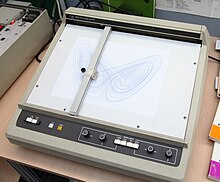A Cartesian coordinate robot (also called linear robot) is an industrial robot whose three principal axes of control are linear (i.e. they move in a straight line rather than rotate) and are at right angles to each other.[1] The three sliding joints correspond to moving the wrist up-down, in-out, back-forth. Among other advantages, this mechanical arrangement simplifies the robot control arm solution. It has high reliability and precision when operating in three-dimensional space.[2] As a robot coordinate system, it is also effective for horizontal travel and for stacking bins.[3]


Configurations
editRobots have mechanisms consisting of rigid links connected together by joints with either linear (prismatic P) or rotary (revolute R) motion, or combinations of the two.[4][5] Active prismatic P and active revolute R joints are driven by motors under programmable control to manipulate objects to perform complex automated tasks. The linear motion of active prismatic P joints may be driven by rotary motors through gears or pulleys. Cartesian coordinate robots are controlled by mutually perpendicular active prismatic P joints that are aligned with the X, Y, Z axes of a Cartesian coordinate system.[6][7] Although not strictly ‘robots’, other types of manipulators, such as computer numerically controlled (CNC) machines, 3D printers or pen plotters, also have the same mechanical arrangement of mutually perpendicular active prismatic P joints.
Joint topology
editA single chain of links and joints connects a moving object to a base of serial manipulators. Multiple chains (limbs) connect the moving object to the base of parallel manipulators.[8] Most Cartesian coordinate robots are fully serial or a combination of serial and parallel connected linkages. However, there are some Cartesian coordinate robots that are fully parallel-connected.[9][10][11]
Degrees of freedom
editSince they are driven by linear active prismatic P joints, Cartesian coordinate robots typically manipulate objects with only linear translation T degrees of freedom. However, some Cartesian coordinate robots also have rotational R degrees of freedom.[12]
Construction
editEach axis of a Cartesian coordinate robot typically is a linear stage consisting of a linear actuator geometrically parallel with linear bearings. The linear actuator is typically between two linear bearings spaced apart from each other to support moment loads. Two perpendicular linear stages stacked on top of each other form a XY table. Examples of XY tables include the XY axes of milling machines or precision positioning stages. At least one of the linear stages of cantilevered Cartesian coordinate robots is supported at only one end. Cantilevered construction provides accessibility to parts for pick-and-place applications such as laboratory automation for example. Cartesian coordinate robots with the horizontal member supported at both ends are sometimes called gantry robots; mechanically, they resemble gantry cranes, although the latter are not generally robots. Gantry robots are often quite large and may support heavy loads.
Applications
editPopular applications for Cartesian coordinate robots are computer numerical control machines (CNC machine) and 3D printing. The simplest application is used in milling machines and plotters where a tool such as a router or pen translates across an X-Y plane and is raised and lowered onto a surface to create a precise design.
Pick and place machines are another application for Cartesian coordinate robots. For example, overhead gantry Cartesian robots are applied for continuous parts loading and unloading on CNC lathes production lines, performing 3-axis (X, Y, Z) pick and place operations of heavy loads with high speed performance and high positioning accuracy. In general, overhead gantry Cartesian robots are suitable for many automation systems.[13]
See also
editReferences
edit- ^ Zhang, Dan; Wei, Bin (2016). Mechatronics and Robotics Engineering for Advanced and Intelligent Manufacturing. Cham: Springer. p. 31. ISBN 978-3-319-33580-3.
- ^ Mingtu, Ma; Yisheng, Zhang (2018). Advanced High Strength Steel And Press Hardening - Proceedings Of The 4th International Conference On Advanced High Strength Steel And Press Hardening (Ichsu2018). Singapore: World Scientific. p. 526. ISBN 978-981-327-797-7.
- ^ Poole, Harry H. (2012). Fundamentals of Robotics Engineering. New York: Van Nostrand Reinhold. p. 35. ISBN 978-94-011-7052-9.
- ^ Craig, John (1989). Introduction to Robotics. Mechanics and Control. Addison-Wesley. ISBN 978-0-201-09528-9.
- ^ Dagalakis, Nicholas G. (1999), "Industrial Robotics Standards", Handbook of Industrial Robotics, Hoboken, NJ, USA: John Wiley & Sons, Inc., pp. 447–459, doi:10.1002/9780470172506.ch24, ISBN 978-0-470-17250-6, retrieved 2020-12-28
- ^ Descartes, Rene (2009-01-01). "Discourse on the method of rightly conducting the reason, and seeking truth in the sciences". Annals of Neurosciences. 16 (1): 17–21. doi:10.5214/ans.0972.7531.2009.160108. hdl:2027/loc.ark:/13960/t20c64v5p. ISSN 0972-7531.
- ^ Klubertanz, George P. (1969). "Discourse on Method, Optics, Geometry, and Meteorology. By Rene Descartes. Trans, with Introd. Paul J. Olscamp". The Modern Schoolman. 46 (4): 370–371. doi:10.5840/schoolman196946493. ISSN 0026-8402.
- ^ Z. Pandilov, V. Dukovski, Comparison of the characteristics between serial and parallel robots, Acta Technica Corviniensis-Bulletin of Engineering, Volume 7, Issue 1, Pages 143-160
- ^ Gosselin, Clement M.; Masouleh, Mehdi Tale; Duchaine, Vincent; Richard, Pierre-Luc; Foucault, Simon; Kong, Xianwen (2007). "Parallel Mechanisms of the Multipteron Family: Kinematic Architectures and Benchmarking". Proceedings 2007 IEEE International Conference on Robotics and Automation. IEEE. pp. 555–560. doi:10.1109/robot.2007.363045. ISBN 978-1-4244-0602-9. S2CID 5755981.
- ^ Gogu, Grigore (2004). "Structural synthesis of fully-isotropic translational parallel robots via theory of linear transformations". European Journal of Mechanics - A/Solids. 23 (6): 1021–1039. Bibcode:2004EuJMA..23.1021G. doi:10.1016/j.euromechsol.2004.08.006. ISSN 0997-7538.
- ^ Wiktor, Peter (2020). "Coupled Cartesian Manipulators". Mechanism and Machine Theory. 161: 103903. doi:10.1016/j.mechmachtheory.2020.103903. ISSN 0094-114X.
- ^ Gogu, G. (January 2009). "Structural synthesis of maximally regular T3R2-type parallel robots via theory of linear transformations and evolutionary morphology". Robotica. 27 (1): 79–101. doi:10.1017/s0263574708004542. ISSN 0263-5747. S2CID 32809408.
- ^ "When do you need a gantry robot". Linear Motion Tips. Danielle Collins. 27 February 2015. Retrieved 21 September 2017.